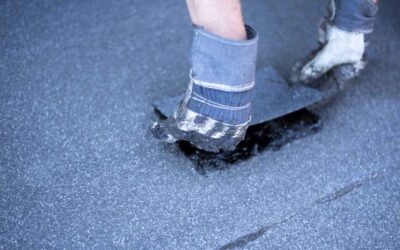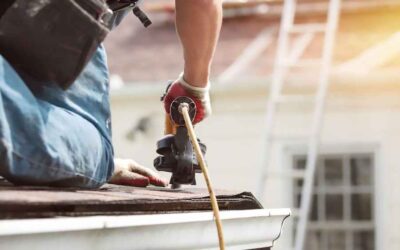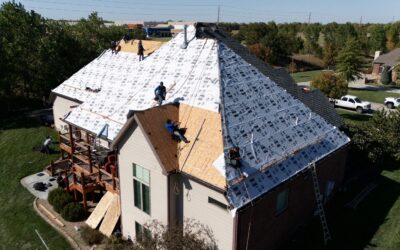A good contractor will walk you through each step of construction (including preparation), let you know what to expect, and make arrangements to protect your home and property. Here at Rhoden Roofing, we’ll make sure you’re covered. As such, this article is intended to be a “what to expect” in case you are nervous about what goes on during a roof replacement, and not a “to-do list” that should cause you any worry. We’ll guide you through the construction process. A few things to be aware of with an upcoming roof replacement or large repair include:
Take Down Fragile or Valuable Wall Decorations
Rarely do we hear about artwork falling off the walls, but hammering on the roof could shake things loose inside the home. Our recommendation: if it’s priceless or irreplaceable and wouldn’t survive a fall, go ahead and take it down just to be safe.
Cover Belongings Stored in the Attic
If you use storage space in the attic, it may be worth covering your belongings. Hammering on the roof during construction knocks dust loose in attic spaces from where it accumulates on rafters. You also may have wafer debris falling from OSB sheathing, sawdust from any new ventilation getting cut, or larger debris if any decking needs to be replaced and sections of the roof are cut open. Save yourself a surprise at the holidays and finding a dusty wreath by moving or covering attic storage.
Turn Your Sprinklers Off (and maybe flag the heads)
We recommend not running sprinklers for a day or two before a roofing construction process. If your contractor has talked to you about needing to move trailers, lifts, or other equipment on your yard because of access, this is especially important to avoid making ruts in soft ground. Even if there won’t be a need to drive on the yard, ladders, generators, and additional foot traffic can sink more into a wet lawn/garden.
Roll in hose lines, and if you have an irrigation system, you might consider flagging the heads to make sure none are hit by equipment. Again, a reputable contractor will meet with you ahead of time with a pre-construction checklist to guide you through this.
Considering Mowing the Lawn
If your grass is particularly long, it may be a good idea to cut your grass prior to your installation. This will make it easier to clean any debris, excess materials or fallen nails after the project. Tall grass, especially once it has been walked on, can hold in debris. A reputable roofing contractor will clean up at the end of the project with rakes and multiple passes of a magnet roller.
Make a Plan for Kids and Pets
Most residential roof replacements are completed in one or two days (see Typical Length of a Roofing Project). While it’s perfectly safe to be inside the home during roofing work, areas outside and adjacent to the home are an active construction area and not appropriate for children or pets. Some pets, especially dogs, are not comfortable with the noise during construction and unfamiliar people coming and going on the property. A basement, interior room (no windows), or offsite is the best for some pets. Count on gates being open into back yards during the day, as crews will need to carry heavy materials and ladders to all sides of the house.
Move Patio Furniture and Breakable Outdoor Décor
Moving your patio furniture away from the house will protect it from moving equipment and any falling debris. Additionally, your contractor may have discussed needing access to certain areas around your home (usually driveways or hardscape patios) for ladders or equipment. We recommend putting away breakable yard ornaments, potted plants, grills, or kids toys that you do not want to risk getting damaged during construction.
Prune Trees Back 6 Feet from Roof Slopes
It’s best to cut back any trees or branches that could be obstructing the roof so the contractor has full access to the roof without interference. Trust an arborist, not a roofer, to take care of the branches for the health and aesthetic of the tree.
Have a Plan for Antennas and Satellite Dishes
We often clean up unused antennas and satellite dishes for customers who no longer want them on the roof, but not all roofing contractors are comfortable doing so. If you have an active array, it may have to be uninstalled by a professional (contact your TV provider) and reinstalled after the roof project is complete.
Move Vehicles Out of the Driveway
Roofing jobs require some large equipment and a trailer, which usually need access to the house via the driveway. In order to make sure you have access to your vehicle(s) during construction, we recommend relocating them ahead of time. Additionally, this keeps vehicles out of the way of any possible falling debris during roof construction.
Let Your Neighbors Know
It’s the neighborly thing to do. Notify those around you that there will be more traffic on the street and that it may be a good day to keep their dogs inside.
A Few Other Considerations:
- Cover the pool – if you have a pool or water feature, keep it covered
- Holiday lights – In some areas of the country, like here in Kansas, roof projects can go on year round with weather accommodating (see our temperature guide article). If your roofing project is scheduled near the holidays, hold off on putting lights up
- Overhead wires – Occasionally, homes (or outbuildings) will have active utility lines hanging low over the roof. Help your contractor by knowing what each wire is and be ready to discuss options for working around them
- Identify Accessible Power Outlets – Your roofing contractor will need access to outlets. Outdoor outlets are preferable, but if none are present, identify a minimal traffic area to run cords from a garage or inside the home.



